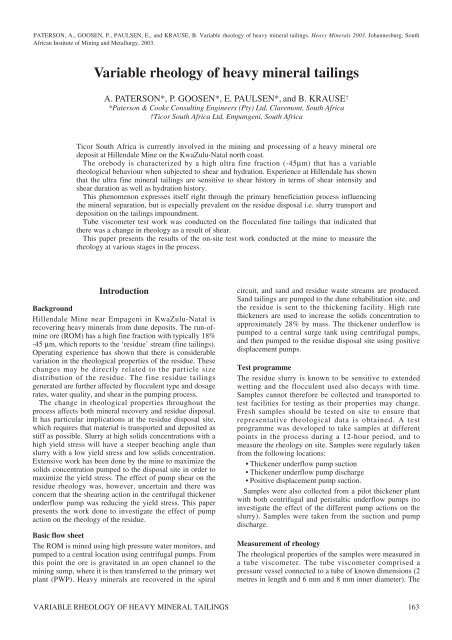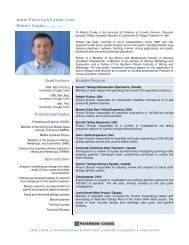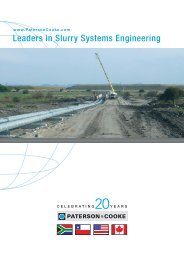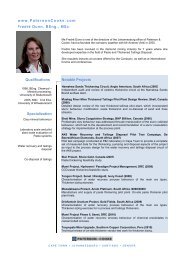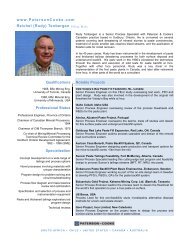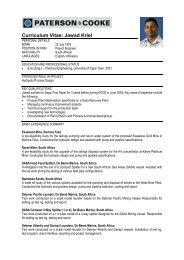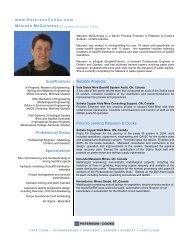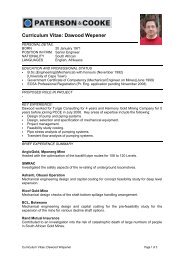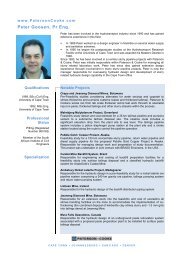Variable rheology of heavy mineral tailings - Paterson & Cooke
Variable rheology of heavy mineral tailings - Paterson & Cooke
Variable rheology of heavy mineral tailings - Paterson & Cooke
Create successful ePaper yourself
Turn your PDF publications into a flip-book with our unique Google optimized e-Paper software.
PATERSON, A., GOOSEN, P., PAULSEN, E., and KRAUSE, B. <strong>Variable</strong> <strong>rheology</strong> <strong>of</strong> <strong>heavy</strong> <strong>mineral</strong> <strong>tailings</strong>. Heavy Minerals 2003, Johannesburg, SouthAfrican Institute <strong>of</strong> Mining and Metallurgy, 2003.<strong>Variable</strong> <strong>rheology</strong> <strong>of</strong> <strong>heavy</strong> <strong>mineral</strong> <strong>tailings</strong>A. PATERSON*, P. GOOSEN*, E. PAULSEN*, and B. KRAUSE †*<strong>Paterson</strong> & <strong>Cooke</strong> Consulting Engineers (Pty) Ltd, Claremont, South Africa†Ticor South Africa Ltd, Empangeni, South AfricaTicor South Africa is currently involved in the mining and processing <strong>of</strong> a <strong>heavy</strong> <strong>mineral</strong> oredeposit at Hillendale Mine on the KwaZulu-Natal north coast.The orebody is characterized by a high ultra fine fraction (-45µm) that has a variablerheological behaviour when subjected to shear and hydration. Experience at Hillendale has shownthat the ultra fine <strong>mineral</strong> <strong>tailings</strong> are sensitive to shear history in terms <strong>of</strong> shear intensity andshear duration as well as hydration history.This phenomenon expresses itself right through the primary beneficiation process influencingthe <strong>mineral</strong> separation, but is especially prevalent on the residue disposal i.e. slurry transport anddeposition on the <strong>tailings</strong> impoundment.Tube viscometer test work was conducted on the flocculated fine <strong>tailings</strong> that indicated thatthere was a change in <strong>rheology</strong> as a result <strong>of</strong> shear.This paper presents the results <strong>of</strong> the on-site test work conducted at the mine to measure the<strong>rheology</strong> at various stages in the process.IntroductionBackgroundHillendale Mine near Empageni in KwaZulu-Natal isrecovering <strong>heavy</strong> <strong>mineral</strong>s from dune deposits. The run-<strong>of</strong>mineore (ROM) has a high fine fraction with typically 18%-45 µm, which reports to the ‘residue’ stream (fine <strong>tailings</strong>).Operating experience has shown that there is considerablevariation in the rheological properties <strong>of</strong> the residue. Thesechanges may be directly related to the particle sizedistribution <strong>of</strong> the residue. The fine residue <strong>tailings</strong>generated are further affected by flocculent type and dosagerates, water quality, and shear in the pumping process.The change in rheological properties throughout theprocess affects both <strong>mineral</strong> recovery and residue disposal.It has particular implications at the residue disposal site,which requires that material is transported and deposited asstiff as possible. Slurry at high solids concentrations with ahigh yield stress will have a steeper beaching angle thanslurry with a low yield stress and low solids concentration.Extensive work has been done by the mine to maximize thesolids concentration pumped to the disposal site in order tomaximize the yield stress. The effect <strong>of</strong> pump shear on theresidue <strong>rheology</strong> was, however, uncertain and there wasconcern that the shearing action in the centrifugal thickenerunderflow pump was reducing the yield stress. This paperpresents the work done to investigate the effect <strong>of</strong> pumpaction on the <strong>rheology</strong> <strong>of</strong> the residue.Basic flow sheetThe ROM is mined using high pressure water monitors, andpumped to a central location using centrifugal pumps. Fromthis point the ore is gravitated in an open channel to themining sump, where it is then transferred to the primary wetplant (PWP). Heavy <strong>mineral</strong>s are recovered in the spiralcircuit, and sand and residue waste streams are produced.Sand <strong>tailings</strong> are pumped to the dune rehabilitation site, andthe residue is sent to the thickening facility. High ratethickeners are used to increase the solids concentration toapproximately 28% by mass. The thickener underflow ispumped to a central surge tank using centrifugal pumps,and then pumped to the residue disposal site using positivedisplacement pumps.Test programmeThe residue slurry is known to be sensitive to extendedwetting and the flocculent used also decays with time.Samples cannot therefore be collected and transported totest facilities for testing as their properties may change.Fresh samples should be tested on site to ensure thatrepresentative rheological data is obtained. A testprogramme was developed to take samples at differentpoints in the process during a 12-hour period, and tomeasure the <strong>rheology</strong> on site. Samples were regularly takenfrom the following locations:• Thickener underflow pump suction• Thickener underflow pump discharge• Positive displacement pump suction.Samples were also collected from a pilot thickener plantwith both centrifugal and peristaltic underflow pumps (toinvestigate the effect <strong>of</strong> the different pump actions on theslurry). Samples were taken from the suction and pumpdischarge.Measurement <strong>of</strong> <strong>rheology</strong>The rheological properties <strong>of</strong> the samples were measured ina tube viscometer. The tube viscometer comprised apressure vessel connected to a tube <strong>of</strong> known dimensions (2metres in length and 6 mm and 8 mm inner diameter). TheVARIABLE RHEOLOGY OF HEAVY MINERAL TAILINGS 163
sample was loaded into the pressure vessel and dischargedthrough the tube at a controlled flow rate (Q m ). Pressureloss and flow rate were recorded, allowing the velocity andwall shear stress to be determined directly. The measureddata is presented in a conventional pseudo-shear diagram,which is a plot <strong>of</strong> pseudo-shear rate (Γ) versus wall shearstress (τ o ), where:Γ= 8V [1]DD∆Pfτ [2]o=4Land V = mean mixture velocity (m/s) = Q m /AD = internal pipe diameter (m)∆P f = pipeline pressure loss due to friction (Pa)L = pipeline length (m).A typical data set and pseudo-shear diagram is shown inFigure 1.The slurry is best modelled using the yield pseudo-plasticmodel in which the yield stress (τ y ), fluid consistency index(K), and flow behaviour index (n) are determined iterativelyfrom a pseudo-shear diagram (Γ and τ o known) using thefollowing relation (Govier and Aziz, 1972):8V4nΓ= =⎛ 1⎞3D τ ⎝ K ⎠1n( τo− τy)n+11o[3]2⎡2( τ − ) ( − )⎤oτyτo τy τy⎢ + 2τ+ ⎥y⎢ 3n+1 2n+1 n + 1⎥⎣⎦The rheological parameters established for each residuesample are correlated against the volume concentration <strong>of</strong>solids (C v ), determined from the following relation:Sm− SwCv=[4]Ss− SWwhere S w = 0.9982 , relative density <strong>of</strong> water at 20°CS m = slurry relative densityS s = solids relative density, 2.61.Effect <strong>of</strong> pump shearingThe analysis <strong>of</strong> the <strong>tailings</strong> was based on the thickenerunderflow pump suction and discharge data only. Thecombined measured suction and discharge pseudo-sheardiagram for a typical thickener (thickener No. 2) is shownin Figure 2. It is seen that the slurry at the suction side has aslightly lower yield stress than the discharge slurry. This isattributed to shearing <strong>of</strong> the slurry and generation <strong>of</strong> ultrafine particles. The suction and discharge data have beenmodelled separately to account for these differences.From Figure 2 it is evident that the residue slurry is foundto be shear thinning i.e. the apparent viscosity decreaseswith increasing shear rate. Furthermore it may be seen thatfor similar slurry densities the <strong>rheology</strong> increases from thesuction to the discharge. This would imply that the slurryexhibits time dependent behaviour in which the <strong>rheology</strong>increases with exposure to shear.Results obtained for a sample from the pilot plant pumpsuction and centrifugal and peristaltic pump discharge arepresented in Figure 3. From the results it is evident thatboth the centrifugal pump and peristaltic pump increase theslurry <strong>rheology</strong> when compared with the data obtained fromthe common suction manifold. This is more pronounced inthe centrifugal pump and is attributed to higher shearintensity in the centrifugal pump.Figure 4 presents the slurry yield stress, Figure 5 the fluidconsistency index, and Figure 6 the flow behaviour index asa function <strong>of</strong> solids concentration by volume. All theparameters are based on the underflow pump suction anddischarge data. The rheological parameters were determinedfrom the measured data using Equation [3].Since there is a difference between the pump suction anddischarge samples, these are identified separately on thegraphs. From these charts it is observed that the yield stressfor the discharge data is generally higher than the suctiondata; however, the fluid consistency index and flowbehaviour index parameters remain relatively constant.Wall Shear Stress, τo (Pa)20018016014012010080604020Sample: Thickener 1 Underflowρ m : 1.181 t/m 300 200 400 600 800 1000Pseudo-Shear Rate, 8V/D (s -1 )Pseudo-shear Wall ShearRate Stress(s -1 ) (Pa)986.0 145.0896.8 142.0783.7 139.1645.7 134.3539.9 129.6449.1 125.0374.9 120.7318.1 116.8267.9 112.8222.9 108.6183.9 104.6157.5 100.8126.3 96.9104.3 93.083.4 89.267.2 83.457.6 79.644.2 72.038.3 68.2Figure 1. Typical data and pseudo-shear diagram164HEAVY MINERALS 2003
200180160Wall Shear Stress, τo (Pa)1401201008060402000 100 200 300 400 500 600 700 800 900 1000Pseudo-Shear Rate, 8V/D (s -1 )1.240 t/m 3 Suction 1.223 t/m 3 Suction 1.161 t/m 3 Suction1.224 t/m 3 Discharge 1.203 t/m 3 Discharge 1.166 t/m 3 DischargeFigure 2: Test tesults for thickener No. 2 suction and discharge400350ρm=1.241 t/m 3Wall Shear Stress, τo (Pa)3002502001501005000 200 400 600 800 1000Pseudo-Shear Rate, 8V/D (s -1 )Centrifugal Pump discharge Peristaltic Pump Discharge Common Pump suctionFigure 3: Test results for the pilot plant at one density1009080Wall Shear Stress, τo (Pa)7060504030201000% 2% 4% 6% 8% 10% 12% 14|% 16% 18% 20%Volume Fraction <strong>of</strong> Solids, C v (%)Suction Data Discharge Data Suction Model Discharge ModelFigure 4: Slurry yield stress versus solids concentration by volumeVARIABLE RHEOLOGY OF HEAVY MINERAL TAILINGS 165
1412Fluid Consistency Index, K (Pa.s n )10864200% 2% 4% 6% 8% 10% 12% 14|% 16% 18% 20%Volume Fraction <strong>of</strong> Solids, C v (%)Suction Data Discharge Data Fitted ModelFigure 5. Fluid consistency index versus solids concentration by volume10.90.8flow Behaviour Index, n0.70.60.50.40.30.20.100% 2% 4% 6% 8% 10% 12% 14|% 16% 18% 20%Volume Fraction <strong>of</strong> Solids, C v (%)Suction Data Discharge Data Fitted ModelFigure 6. Flow behaviour index versus solids vehicle concentration by volumeConclusions• The residue slurry behaves as a time dependent yieldpseudo-plastic fluid i.e. it exhibits shear thinningbehaviour, and the <strong>rheology</strong> increases with exposure tointense shearing (as in a centrifugal pump)• The rheological parameters have been determined asfunctions <strong>of</strong> the volumetric concentration <strong>of</strong> solids• The slurry <strong>rheology</strong> tends to increase as it passesthrough a pump (increase in yield stress). The increasein <strong>rheology</strong> is attributed to the generation <strong>of</strong> fineparticles during shear. This effect is decreasedconsiderably as the density decreases• The <strong>rheology</strong> <strong>of</strong> the slurry measured at the discharge <strong>of</strong>a centrifugal pump is greater than the <strong>rheology</strong>measured at the discharge <strong>of</strong> a peristaltic pump on acommon manifold. The difference is attributed to themore intense shear in the centrifugal pump• Finally it is concluded that pumping the residue in ahigh shear pump, such as a centrifugal pump, will notreduce the residue yield stress but rather increase it.ReferencesGOVIER, G.W. and AZIZ, K. The flow <strong>of</strong> complexmixtures in pipes. Von Nostrand Reinhold Company,1972.166HEAVY MINERALS 2003


